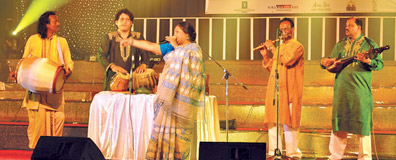|
Norway- Sri Lanka music cooperation:
Cultures piece together at 'Oriental Music Orchestra'
Chamikara WEERASINGHE
Diversity of cultures does not collide with music. Fusion of symbolic
music traditions in ethnic music stands to eliminates common confusions
in ethnic politics. When music of two or more ethnic traditions meets in
one room, it creates a delightful ambience. The result is ethnic harmony
of top quality. It raises finer sentiments of our human hearts to
respect, accept and appreciate cultural differences.
 |
|
Concerts Norway Sloveig Korum awards
Kumara Liyanawatta. |
This atmosphere spread out as members of Sri Lanka's National
Oriental Music Orchestra, consisting of talented young musicians from
diverse cultures, performed at the New Kathiresan Hall, Colombo on
Tuesday.
Classically different
The orchestra presented different ethnic and regional music
traditions in the country on a classical footing. It was an educational
and community engagement effort by the Royal Norwegian Government.
Norwegian Embassy and Concerts Norway had funded the project under the
Music Cooperation between Norway and Sri Lanka. The project's steering
committee was advised by the Institute of Human Excellence (IHE), and
Aru Sri Art Theatre that spearheaded the project.
The project brought together hundred talented young musicians from
various parts of the country to form Sri Lanka's first multi-ethnic
oriental Orchestra in Sri Lanka with Sinhala, Tamil Muslim and Burgher
artistes.
The young artistes had undergone six month's music training before
they were directed to the Orchestra. Prominent musicians of the country,
Arunthathy Sri Ranganathan, Dr Nirmala Kumari Rodrigo, Kumara
Liyanawatte, Somasiri Ileysinhe, S Mahendran, Wijeratne Ranatunge, Dr
Balambigai Rajeswaran and Piyasara Silpathipathi coached the artistes.
Arunthathi Sri Ranganathan was the artistic consultant who had
determined the repertoire of music performed.
The orchestra resembled a South Indian Carnatic appearance and
flavour. The musical instruments were mainly from the Carnatic string
family.
Ancient and unique
 |
|
Bangladesh
performers |
The orchestral set up included some of the ancient and unique musical
instruments of Tamil Nadu such as Nadaswaram and Miridanga, used in
Carnatic classical music. The orchestra is divided into sections of
Sitars: Sarangis, Sarods, Esrajs and Dilrubas together with Hindustani
flute, violin, Mohan Veena, harmonium, tabla, Packwaj, Santhoor, Thavil,
Uddukkai, Veena, Parai, Urumi, Thappu, Muharsingh, Ganchira, Kadam,
Suththamaththalam, Kottu vathiyam, Murasu, Kombu, Pullangulal-Carnatic
and Violin-Carnatic. The Oriental Music Orchestra began their first
rendition, Vaathaapi-Keerthanam based on Hamsathawani Rag on Aadhi
Thaalam, which was originally composed by Muthuswami Deekshithar,
arranged by Kalasoori Arunthathy Sri Ranganathan. She also conducted a
composition titled 'Ragamalika', a garland of Indian Ragas based on
Carnatic flavour.
It was followed by Hindusthani classical compositions by Sangeeth
Visharada Somasiri Illesinghe. The rendition was based on Basanthi
Bairavi Rag on Three Thaal.
The Orchestra's next performances were a piece composed by Dr Nimala
Kumari Rodrigo. It was based on Niyan Ki Malhar and Raga Bahar, which
inspired the audience. The Sinhala folk drums, Gata Bera, Pahatharata
Bera, Sabaragamuwa Bera chipped in as the orchestra played a section of
favourite folk melodies of Sri Lankan origin in a presentation conducted
by Kumara Liyanawatta. The music reverberated the air with a blend of
Carnatic sounds extending over Sinhala folk. A Sequel to the renditions
based on south Indian classical music, the international artistes from
Norway, India, Bangladesh and Palestine took the stage. They added
further colour and meaning to the event.
Natural harmony
 |
|
Norwegian duo Mari Forr Klapbakken and
Julie Alspnes Normann of Litjtausa. |
Bangladesh Chhayanaut Baduls opened up the stage with Baul geeti
(Baul songs), a style that focuses on the love of society and the
harmony in nature. Chhananaut Baduls performed their rich folk songs
with much emphasis on traditional percussion. As is often the case and
the tradition of Bangladesh music, they brought the element of dance to
the floor with an awesome percussionist who moved the audience with his
dhol drumming and bhangra dancing.
Palestinian group, Sabrine performs regional sub-genres of Arabic
music before two slender waist beauties from Norway hit the stage with a
couple of fiddles to become the centre of attraction. Norwegian duo Mari
Forr Klåpbakken and Julie Alspnes Normann of Litjtausa, played
wonderfully on the stage delivering haunting sounds of Norwegian dance
music on their fiddles starting with one of their own compositions. They
filled the air with energy and enthusiasm as they went onto play
legendary Michael Jackson tune 'Smooth Criminal'.
India's experienced ensemble, Raghu Dixit Project also performed
their music based on Indian folk genre at the concert. Present on This
occasion were Norwegian Ambassador H H Hilde Haroldstad, Tom Gravlie and
Sloveig Korum, Institute of Human Excellence Chairman D M Swaminathan
and Director Vyasah Kalyanasunderam, who awarded all the musicians and
composers that contributed to the success of the Oriental Music
Orchestra. |



